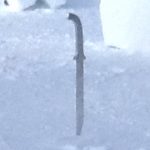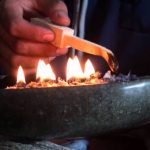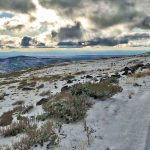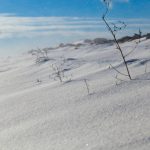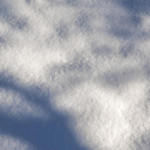Overview
Snow is a central component in Inuit Land survival. In addition to building shelters and navigating, it provides water for people travelling on the land. However, as students will learn in this lesson, not all types of snow are equal when it comes to hydration.
At the end of this lesson, students will be able to determine the percentage of water in a snow sample through experiment and/or calculations, identifying the type of snow that contains the most water.
Outcomes
By formulating an hypothesis, proceeding to an experiment and come to a consensus on the interpretation of the results, students will demonstrate the competency: seeking answers or solutions to scientific or technological problems.
Knowledge
- Characteristics of different types of snow (density, water percentage) and appropriate vocabulary and units of measure to describe them.
Skills
- Identifying different types of snow using the panak
- Sampling, using a scale, reading a volume
- Formulating an hypothesis and sharing results with others
Attitudes
- Inquisitiveness
- Openness to others
- Aim for precision
Flow
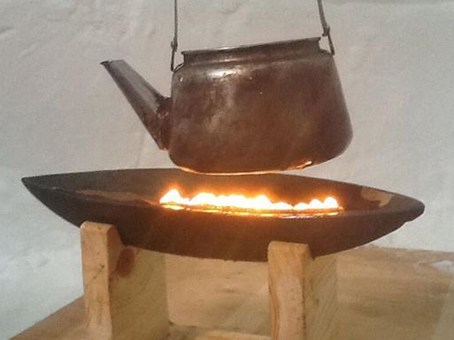
Picture by Charlie Nowkawalk
1. Melting Snow
Qaujisartuq: the emergent learner is observing and listening
Combine this introduction to an excursion on the land, or make it an activity in itself. Take your students on the land and prepare tea for the group by melting snow in a pot. Emphasize on the change in volume and make connections to the changes of phases. It is an ideal time to invite a knowledge holder to talk about the types of snow, their importance and uses.
Although there is a multitude of types of snow, we suggest working with the following three.
Aqilluqaq
Soft powdery snow, new snow
Sitilluqaq
Hard compacted snow, old snow
Pukajaq
Type of snow formed of small-sized crystals
As you enjoy your tea on the land, make sure that students are familiar with some characteristics of these types of snow such as look, texture, weight, hardness, etc. Enhance student’s awareness of the types of snow by asking questions:
- How can you recognize x type of snow?
- What is different between these two types of snow?
- Which word would you use to describe x type of snow?
2. Percentage of water in snow
Tukisinaksijuq: the communicative learner develop their awareness by repeating a task that they know how to complete
Suggest a challenge to your students. On the land, their task will be to identify the type of snow that provides the most drinking water. We suggest proceeding to this experiment with the three types of snow mentioned above (aqilluqaq, sitilluqaq, pukajaq).
- On the land, students use the the best of their knowledge find these types of snow.
- Then, they will formulate an hypothesis as to which type of snow contains the most water.
- Using the protocol(s) below, they will test their hypothesis and determine which of aqilluqaq, sitilluqaq or pukajaq has the highest percentage of water.
There are two different ways to proceed to this experiment. You could choose just one or both, make two groups who will compare their results, make this activity twice… it is up to your professional autonomy.
2.1. Ratio Method
The first method is to compare the volumes (ml) of snow and water from a sample that is melted. This can then be expressed in a simple ratio or converted to percentage. This method is great to teach about changes of phase and is more authentic to the way Inuit use snow to make drinking water. However, it does not explain why different types of snow contain different amounts of water.
- Use the beaker to take a sample of snow (without compacting it).
- Note the quantity of snow in the beaker in milliliters.
- Melt the snow in the pot.
- Put the water back into the beaker.
- Note the quantity of water in the beaker in milliliters.
- Repeat for each type of snow by making sure to collect the same amount of snow each time.
As the activity goes on, ask questions to the students to deepen their reflection on what they are doing.
- Hypothesize which type of snow will produce the most water.
- What will happen to the volume when you melt your snow?
- What would happen if you leave the water boiling for too long ?
- Could someone cheat the results of this experiment ? How ?
2.2. Density Method
The second method is to convert the density of the snow (mass over volume) into percentage of water in snow. Since water has a density of 1g/ml, snow that has a density of 0,1g/ml therefore contains 10% water. This method is the one generally used by scientists to determine the percentage of water in snow. It is interesting because establishes the link between density and percentage of water in snow. However, it requires more calculation and is more remote from the way Inuit use snow to make drinking water.
- Weight the empty beaker and note its weight in grams.
- Use the beaker to take a sample of snow (without compacting it).
- Weight the full beaker and note its weight in grams.
- Calculate the net weight of the sample.
- Note the quantity of snow in the beaker in milliliters.
- Divide the mass (g) by the volume (ml) to obtain the snow sample’s density in g/ml.
- Compare the snow density to water density (1g/ml), thereby eliminating the units, by dividing the sample mass/volume by water mass/volume.
- Convert the result into percentage by multiplying by 100.
- Repeat for each type of snow by making sure to collect the same amount of snow each time.
Ask students to explain in their own words why the density of the snow is related to the percentage of water in snow.
3. Discussion & Consensus
Tukisinaksijuq: the communicative learner reflects on the results with others and draws connections to other knowledge
On the land or in the classroom, discuss the results of this experiment. Compare student’s results within or across methods.
It is a good time to expand on the concept of phases and change of phases from snow to water and eventually steam or on density and its relationship to water percentage. You can also address some biases that you noticed in the experimentation, such as students boiling away their water, collecting irregular amounts of snow or not determining the net weight of their samples.
To conclude, ask your students to come to a consensus, informed by their results, on the best type of snow to melt into drinking water (quantity wise). This part of the lesson is culturally significant, as consensus (aajiiqatigiiniq) is an important way of coming to a decision in Inuit culture.
Assessment
For this lesson, we suggest focusing the assessment on the experimentation as part of the scientific method. Such an assessment includes not only how accurately students follow the protocol, but most importantly if they can identify potential biases, understand the importance of the constraints and can relate the results of their experiments to the hypothesis they formulated.
All
All students will be able to formulate an hypothesis about water percentage and to follow the steps of one of the protocols. They will identify their difficulties.
All students will be at the transitional stage of learning (Tukisilirtuq) where they are applying a procedure they learned. With help, they will talk about their success and difficulties.
Most
Most students will confirm or infirm their hypothesis after following the steps of one of the protocols and share their results. They will recognize errors or biases.
Most students will reach the communicative stage of learning (Tukisinaksijuq), sharing and reflecting on results with others.
Some
Some students will additionally understand the relationship between the two protocols and use accurate information to take part in the conversation about results. They will identify and sometimes avoid biases.
Some students will go further in the communicative stage (Tukisinaksijuq) by drawing connections between the two protocols and beginning to think critically about the process.
Extensions
- If you did not already, introduce both of the protocols to determine the percentage of water in snow and put them in relationship.
- Put the percentage of water in snow in relation with more data gathered through the other snow lesson plans.
Materials
- Beaker
- Scale
- Coleman stove (or other source of heat)
- Pot or kettle
- Calculator (optional)
- Provided worksheets (1 for each protocol)
- Pencil
- Clipboard (optional)
Vocabulary
- Aqilluqaq (soft powdery snow, fresher snow)
- Sitilluqaq (hard compacted snow, older snow)
- Pukajaq (crystallized snow)
- Panak (snow knife)
- Pukarlaq (type of snow formed of large-sized crystals, known to produce the most drinking water when melted)
- Qanittaq (treshly fallen snow, known to produce the least drinking fater when melted)
References
United States National Park Services (n.d.). How Much Water is in this Snow? Document accessible at: https://www.nps.gov/glac/learn/education/upload/How%20much%20water%20is%20in%20this%20snow%20activity.pdf
NASA Student Observation Network (n.d.). Snow Pit Procedures. Document accessible at: https://www.nasa.gov/pdf/186123main_SnowPitProcedures.pdf

